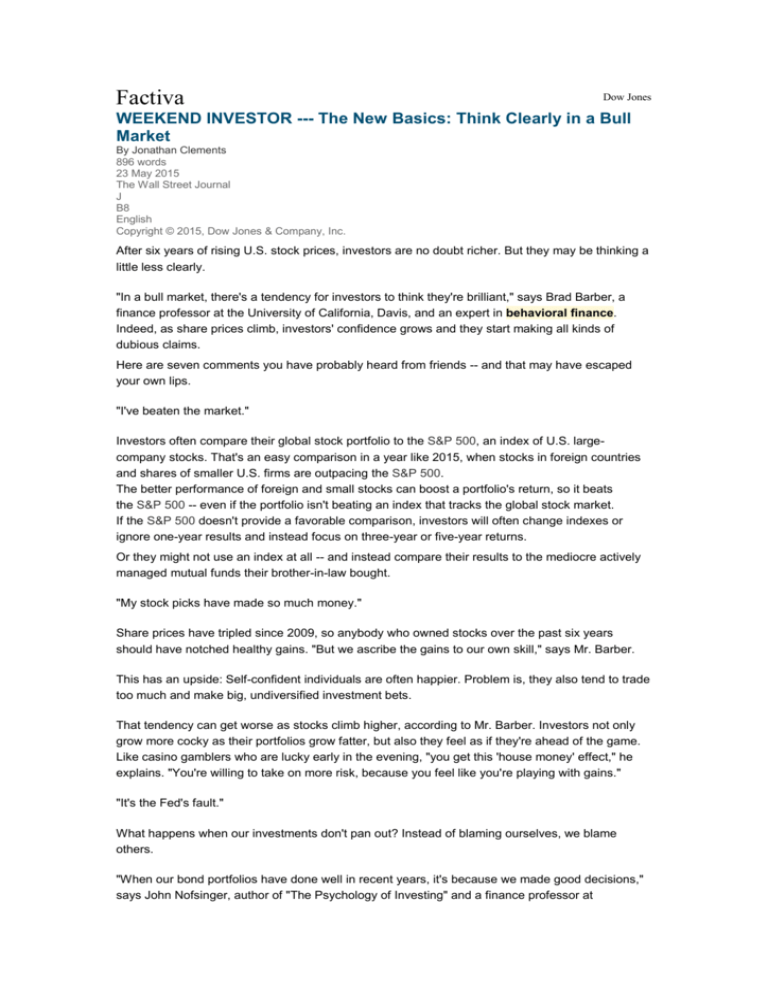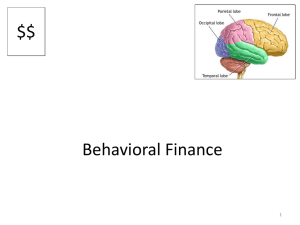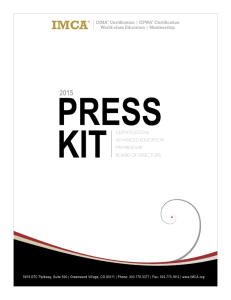
Factiva
Dow Jones
WEEKEND INVESTOR --- The New Basics: Think Clearly in a Bull
Market
By Jonathan Clements
896 words
23 May 2015
The Wall Street Journal
J
B8
English
Copyright © 2015, Dow Jones & Company, Inc.
After six years of rising U.S. stock prices, investors are no doubt richer. But they may be thinking a
little less clearly.
"In a bull market, there's a tendency for investors to think they're brilliant," says Brad Barber, a
finance professor at the University of California, Davis, and an expert in behavioral finance.
Indeed, as share prices climb, investors' confidence grows and they start making all kinds of
dubious claims.
Here are seven comments you have probably heard from friends -- and that may have escaped
your own lips.
"I've beaten the market."
Investors often compare their global stock portfolio to the S&P 500, an index of U.S. largecompany stocks. That's an easy comparison in a year like 2015, when stocks in foreign countries
and shares of smaller U.S. firms are outpacing the S&P 500.
The better performance of foreign and small stocks can boost a portfolio's return, so it beats
the S&P 500 -- even if the portfolio isn't beating an index that tracks the global stock market.
If the S&P 500 doesn't provide a favorable comparison, investors will often change indexes or
ignore one-year results and instead focus on three-year or five-year returns.
Or they might not use an index at all -- and instead compare their results to the mediocre actively
managed mutual funds their brother-in-law bought.
"My stock picks have made so much money."
Share prices have tripled since 2009, so anybody who owned stocks over the past six years
should have notched healthy gains. "But we ascribe the gains to our own skill," says Mr. Barber.
This has an upside: Self-confident individuals are often happier. Problem is, they also tend to trade
too much and make big, undiversified investment bets.
That tendency can get worse as stocks climb higher, according to Mr. Barber. Investors not only
grow more cocky as their portfolios grow fatter, but also they feel as if they're ahead of the game.
Like casino gamblers who are lucky early in the evening, "you get this 'house money' effect," he
explains. "You're willing to take on more risk, because you feel like you're playing with gains."
"It's the Fed's fault."
What happens when our investments don't pan out? Instead of blaming ourselves, we blame
others.
"When our bond portfolios have done well in recent years, it's because we made good decisions,"
says John Nofsinger, author of "The Psychology of Investing" and a finance professor at
the University of Alaska Anchorage. "But when it comes to the bond market's recent bad
performance, we blame the Fed."
Bonds have struggled over the past month, as the yield on the benchmark 10-year Treasury note
has climbed from below 1.9% to above 2.2%, driving down bond prices.
Alternatively, we might simply rewrite history. "We misremember to make ourselves feel better,"
Mr. Nofsinger says. "We just ignore the fact that our 401(k) didn't do that well last year."
"My portfolio has grown so much."
That may be true. But how much of the growth has come from the savings we have added, rather
than from investment gains?
If we're disappointed by our investment performance, "we can change from measuring investment
return to investment level," Mr. Nofsinger says. "If my return is negative but contributions allowed
the level to still increase, I can focus on the level."
"It's only a paper loss."
If we buy a $10 stock that falls to $8, we have lost money. But many investors don't see it that
way.
"People feel that paper losses are different from real losses," notes Meir Statman, a finance
professor at California's Santa Clara University and author of "What Investors Really Want." The
reason: There's still a chance that the shares will bounce back.
What happens when we finally sell that losing stock? We quietly drop it from our mental arithmetic
-- and now we can boast to our neighbors that we've made money on every stock we own.
"I bought it for diversification."
When an investment doesn't perform the way we expect, we will often mentally reclassify it. Take
gold, which was all the rage after its price jumped more than sevenfold over the decade through
2011.
But instead of continuing to soar, gold has lost more than a third of its value since September
2011. What to do? We might drop it from the "it will make me rich" portion of our portfolio -- and
reclassify it as "it might do well if we get another financial crisis."
"This time, I'll get out before the crash."
In hindsight, market tops and bottoms seem obvious, so we figure we'll see the next one coming.
But the current bull market's peak will probably be just as murky as the low point of the last bear
market, in March 2009.
"We can now see that that was the bottom of the market," Mr. Statman says. "But at the time, you
couldn't see the pattern."
--Jonathan Clements is the author of the "Jonathan Clements Money Guide 2015."
ClementsMoney@gmail.com
License this article from Dow Jones Reprint
Service[http://www.djreprints.com/link/DJRFactiva.html?FACTIVA=wjco20150523000075]
Dow Jones & Company, Inc.
Document J000000020150523eb5n0001z
News
IMCA Launches Online Behavioral Finance Program
By Danielle Andrus
340 words
27 April 2015
ThinkAdvisor
ADVONE
English
Copyright © 2015 ALM Media, All Rights Reserved.
The Investment Management Consultants Association announced on Monday that it is introducing
a new online behavioral finance program. The program is designed to help advisors address
common financial decisions that trip up investors, and will be delivered by noted behavioral
finance experts like Dan Ariely and Meir Statman.
Andrew Lo, director of MIT’s Laboratory for Financial Engineering, who was recently named as
faculty advisor to another online education program for IMCA through the MIT Sloan School of
Management, will also be involved.
The decision to include behavioral finance education was based in part on recent job task
analyses for the certified investment management analyst (CIMA) and certified private wealth
advisor (CPWA) designations that required IMCA to expand that type of content in its certification
programs, according to a press release.
Furthermore, IMCA noted that its members are asking for that kind of education. Eighty-five
percent of members surveyed this year said they would be at least somewhat interested in
learning about behavioral finance at an advanced level.
“Today’s advisors must possess expert behavioral finance savvy to competently guide their
clients’ investing decisions and build durable portfolios,” Sean Walters, IMCA’s executive director
and CEO, said in a statement. “IMCA has built a premier reputation for our live education offerings,
but we feel that high-quality education can be delivered in a variety of media.”
The new program will be conducted online and includes between 15 and 20 hours of education in
the form of slides or video, speaker notes or readings, and quizzes. It’s expected to launch this
summer.
IMCA announced in February that it will offer an online education program through the MIT Sloan
School of Management leading to its CIMA certification beginning June 1. Advisors working toward
the CIMA certification must complete 40 hours of online work, and complete section quizzes and
an exam within a 60-day window.
--- Read IMCA to Offer Online Courses With MIT Sloan for CIMA
Certification[http://www.thinkadvisor.com/2015/02/11/imca-to-offer-online-courses-with-mit-sloanfor-ci] on ThinkAdvisor.com.
ALM Media LLC
Document ADVONE0020150428eb4r00005
How to Incorporate Behavioral Finance Theory into a Planning
Practice
Peggy Doviak
181 words
1 March 2015
Journal of Financial Planning
JFN
30
Volume 28; Issue 3; ISSN: 10403981
English
© 2015 Journal of Financial Planning. Provided by ProQuest Information and Learning. All Rights Reserved.
Several strategies for better understanding and implementing behavioral finance in your
practices are presented. First, study the subject and read in the field. From the readings, choose
specific exercises or topics that you find especially interesting. Once you feel confident enough to
use the exercises and activities with your clients, begin to implement them with clients whom you
believe will be most receptive. When determining the kind of bias becomes important, drill down to
the major categories. It takes more time to explain behavioral finance to existing clients than it
does to add it to the new client onboarding process. Keep the conversation focused on how the
client's belief or bias is affecting the current planning and investing situation. Try to find a money
coach, money therapist, psychologist, or other professional who is trained to work with people and
their money psychology.
Whether you choose to deal with your clients' behavioral finance biases and errors in judgment,
they will still have them.
Copyright Financial Planning Association Mar 2015
Financial Planning Association
Document JFN0000020150310eb3100008
Understanding: Behavioral Aspects of Financial Planning and
Investing
H Kent Baker; Victor Ricciardi
151 words
1 March 2015
Journal of Financial Planning
JFN
22
Volume 28; Issue 3; ISSN: 10403981
English
© 2015 Journal of Financial Planning. Provided by ProQuest Information and Learning. All Rights Reserved.
Investor behavior often deviates from logic and reason. From the financial planner's perspective,
such factors increase the difficulty of comprehending clients' judgments. Consequently,
appropriate financial planning policies can play a powerful role in keeping clients committed to a
consistent and disciplined course of action and in avoiding such biases. Ignoring or failing to grasp
this concept can have a detrimental influence on investment performance. The authors' purpose is
to examine some behavioral aspects of financial planning and investing. They begin by
differentiating between traditional or standard finance and behavioral finance and stressing the
importance of understanding investor psychology. They then focus on how behavioral biases,
emotions, and systematic cognitive errors can affect investment decisions. They conclude with a
few observations about how understanding investor behavior can help improve decision-making
processes.
Copyright Financial Planning Association Mar 2015
Financial Planning Association
Document JFN0000020150310eb3100006
Search Summary
Text
behavioral
finance
Date
In the last 3
months
Source
All
Publications
Author
All Authors
Company
All
Companies
Subject
All Subjects
Industry
All
Industries
Region
All Regions
Language
English
Results Found
185
Timestamp
26 May
2015 23:21
© 2015 Factiva, Inc. All rights reserved.









